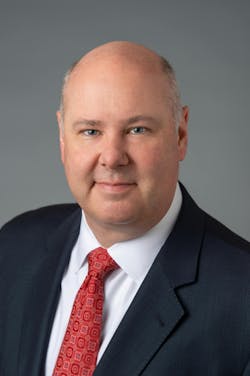There’s a New Sheriff in Town at NAHB: Jim Tobin Becomes CEO
On May 4, The National Association of Home Builders (NAHB) announced James (Jim) Tobin as its new chief executive officer following the retirement of Gerald (Jerry) Howard after 22 years at the helm. Tobin will assume the new post effective June 1, 2023. Tobin was most recently NAHB’s chief lobbyist and EVP of government affairs and guided the activities of its political action committee, BUILD-PAC. As CEO, he will oversee an association with more than 200 employees, many of whom are located at the National Housing Center in Washington, D.C., serving 140,000 members nationwide.
Tobin joined NAHB in 1998 as a congressional representative involved in grassroots organizing and policy analysis. Before becoming NAHB’s chief lobbyist in 2011, he was NAHB’s VP for federal relations. Prior to NAHB, he was senior legislative assistant to former U.S. Representative Frank Riggs (R-CA) and former U.S. Representative Gary Franks (R-CT).
Pro Builder: What is the role of CEO at NAHB?
Jim Tobin: First and foremost, the CEO leads the NAHB staff team. I believe we're the most talented association staff in Washington, D.C., and nationwide, and so it's a great privilege for me as a longtime staff member who worked my way up through the ranks to now lead this great team.
PB: What are your goals and intentions, internally and externally?
JT: NAHB is a complex organization, but that's because our industry is complex and touches so many different things. And it’s not just housing, but also tax policy, environmental policy, and small-business policy. It's a big undertaking, and we’re looking at how we're going to operate in the future, the ways we should be structured, the programs and the services we want to bring to the membership, and build a staff that satisfies what the members need from us now. It's a really exciting time.
I also want to make sure we continue to deliver on the advocacy work we do and that the advocacy team continues to be a great machine for the industry. We also want to make sure we're satisfying the needs of the Federation and that our local and state associations have the right tools from NAHB, including the delivery of a best-in-class residential construction show at the International Builders’ Show.
RELATED
- 7 Questions With Alicia Huey, 2023 NAHB Chairman
- NAHB Develops Land Use Resources for Home Builders and Buyers
- Construction Workforce Development Gets New Funding Boost
PB: What do you think is your biggest learning curve as CEO?
JT: It's pivoting to learn all of the other corners of the association. I'm going to continue to learn and listen, lean on a great staff team, and ask questions about how we get from here to there.
PB: In your opinion, what kind of challenges does the association have in getting its point across and affecting change in Congress and at the White House?
JT: Number one, I think our voice is being heard. When we go to Capitol Hill and we go to the White House, everybody understands that housing affordability is a crisis right now and there are different ways of tackling the issue. Some in Washington want to just throw more money at the problem, while others want to find ways to lower the cost of housing through more supply. But everybody understands housing is a prime issue across the country.
I think one of the biggest challenges is that we are such a well-housed nation. Obviously, we have a huge homeless problem in many parts of the country, and I talked about the affordability issue, but by and large, we're very fortunate as a nation to have a robust housing economy.
The hard part is making housing a political issue for presidential and congressional candidates. They may talk about housing, but is that really what's going to drive them in the polls to win in November of 2024? How do you get people to come out and vote on housing as much as they do on other issues? That's our challenge.
PB: Change is always difficult to some degree. How do you view it?
JT: I look at changes as enormous opportunities. In government affairs, every two years we get a new Congress and every four years we get a new administration, and that's always an opportunity to evaluate where you've been and where you're going and to use new tools at our disposal to create and raise some issues higher.
It's the same here at NAHB. Changes come that force us to reevaluate the Federation. Sometimes it's external, like the pandemic, but this one's internal. We're losing our long-time CEO Jerry Howard, and so this is an opportunity to review where we are and move forward.
About the Author

Rich Binsacca, Head of Content
Rich Binsacca is Head of Content of Pro Builder and Custom Builder media brands. He has reported and written about all aspects of the housing industry since 1987 and most recently was editor-in-chief of Pro Builder Media. [email protected]

